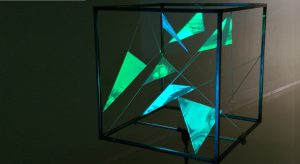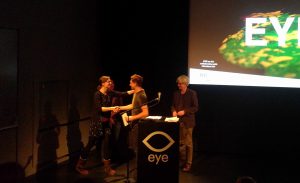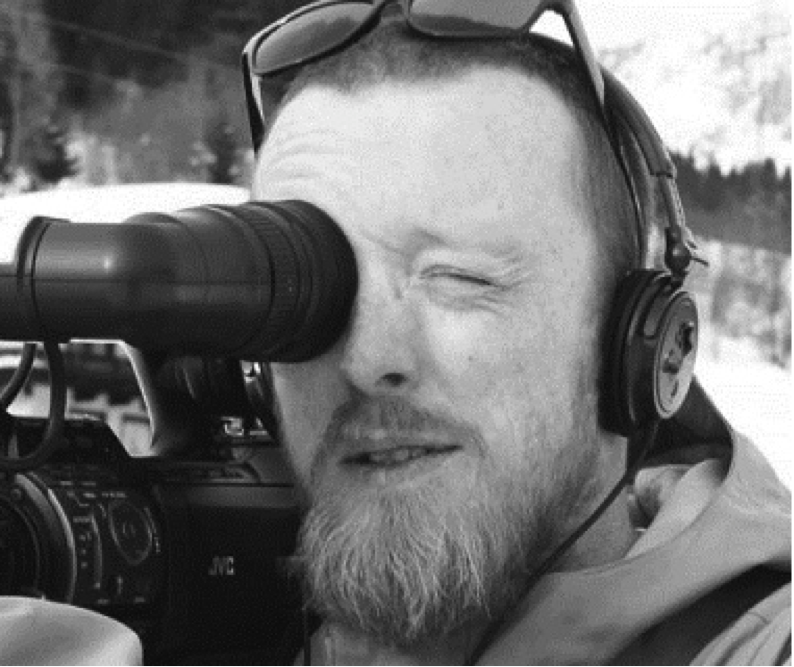To graduate as a VJ at or VjAcademy you need to create an original, personal video project. This year, for the first time, our students presented their final exam work at the EYE Film museum, within the “Research Lab” program. Research Lab consists of two one-day expositions, and is collaboration between EYE and seven media/art academies. Robin van Creij won the Best Original Work jury prize with his Sentient Chandelier.
Robin van Creij – Sentient Chandelier
Fabric suspended in steel frame, sensors, computer animations, digitally processed film footage, digital beamer, stereo boxes.
Robin van Creij (1991) is doing his final exam on both St. Joost as VjAcademy in 2017, as a video animation designer and VJ.
 In this VJ installation, Robin van Creij makes these Bits and Pieces shine once again. They no longer need further context, a story or an explanation as they become a part of a decorative piece of furniture. The installation is an irregular sculpture of bits and pieces of material, onto which the film fragments are projected. This interactive ‘chandelier’ generates and reflects projections of the lost and found footage. The behaviour of people nearby is picked up by sensors and translated into the display of certain fragments and an array of special effects to transform their appearance.
In this VJ installation, Robin van Creij makes these Bits and Pieces shine once again. They no longer need further context, a story or an explanation as they become a part of a decorative piece of furniture. The installation is an irregular sculpture of bits and pieces of material, onto which the film fragments are projected. This interactive ‘chandelier’ generates and reflects projections of the lost and found footage. The behaviour of people nearby is picked up by sensors and translated into the display of certain fragments and an array of special effects to transform their appearance.
Usually during a concert, a VJ’s audience has limited and only indirect influence on the projections. In the best case scenario, the expression of their mood is observed by the VJ and taken into account in the evolving vibe of his live show. In classic cinema interactivity is even practically zero. At home however, Netflix gives the viewer full control over the second-by-second replay of an enormous library of cinema. In this project that level of interactivity -now with Bits and Pieces of cinema content transformed to VJ content- is brought to the same livingroom. The viewer becomes the VJ and creates his personal esthetic VJ experience.
Jury Award: Best original work
 “The prize of the best original work was attributed to Robin van Creij (VJ Academy and AKV|St.Joost) for his installation Sentient Chandelier. Using the Bits & Pieces from the EYE archives as source material, Robin created an installation that artistically played with the concept of the ‘fragment’ in a 3-dimensional work that is playful, interactive and communicative. The realization of the work was carefully done with great attention for detail and quality. The Sentient Chandelier is imaginative and highly original and is exemplary for artistic use of archival footage to create new meanings and experiences. The jury considered this especially interesting in the context of EYE as an institute for the promotion and presentation of archive films. This installation therefore coincides very well with the objectives and framework of EYE.”
“The prize of the best original work was attributed to Robin van Creij (VJ Academy and AKV|St.Joost) for his installation Sentient Chandelier. Using the Bits & Pieces from the EYE archives as source material, Robin created an installation that artistically played with the concept of the ‘fragment’ in a 3-dimensional work that is playful, interactive and communicative. The realization of the work was carefully done with great attention for detail and quality. The Sentient Chandelier is imaginative and highly original and is exemplary for artistic use of archival footage to create new meanings and experiences. The jury considered this especially interesting in the context of EYE as an institute for the promotion and presentation of archive films. This installation therefore coincides very well with the objectives and framework of EYE.”
Serina Giesbers – The Box
Cardboard and wood, computer animations, digitally processed film footage, digital beamers, stereo boxes.
Serina Giesbers (1991) works as a 3D-artist and VJ. She’s interested in combining innovative 3D-software and hardware with traditional filmed imagery.
 Inside The Box a sculpture is imprisoned, aching for freedom, longing to break its boundaries. A confrontation is inevitable, as these boundaries don’t intend to let anything pass just like that. Unwielding gatekeepers, these physical limitations are intent on keeping their treasure inside, and are willing to go all-out in the upcoming struggle.
Inside The Box a sculpture is imprisoned, aching for freedom, longing to break its boundaries. A confrontation is inevitable, as these boundaries don’t intend to let anything pass just like that. Unwielding gatekeepers, these physical limitations are intent on keeping their treasure inside, and are willing to go all-out in the upcoming struggle.
The Box is a cube situated in one of the corners of the exhibition space. Projections reveal both the nature of the The Box, and what’s inside. The fight between inside and outside is visualised in an array of optical illusions and effects. Once the sculpture inside succeeds in breaking out, it rips apart its boundaries and manifest itself all over the wall in an intense audiovisual cry of triumph.
An intense and new experience is also what Serina Giesbers aims to offer the audience. She likes the idea that such experiences have dualistic nature: they exist only in a brief moment, yet they may leave a lasting impression. While looking for such experiences, are we trying to discover and explore our own world? Or are we trying to go beyond and to break free of our physical cage?
For this installation Serina Giesbers used the VJ technique of 3D projection mapping. It’s a clever way to employ geometry and knowledge of optical depth perception to seemingly change the surface of e.g. buildings or stage objects. Colors and textures can be manipulated in the blink of an eye, but even the entire shape of the structure can seem to change and move. Or escape!
Nienke Mink – Control of the Animal Kingdom
Digitally processed wildlife recordings, live music and video performance, projection with digital beamer.
Nienke Mink (1990) loves to mix many media approaches and techniques and is a true allrounder.
 In her project, Nienke Mink wants to reinvent the way we watch wildlife documentaries. After a journey to South Africa, she found that traditional documentaries lacked something essential as compared to real nature: the unexpected. It’s linear narrative based structure has become rigid and predictable. Using VJ improvisation techniques, Nienke invites us to a more realistic, unscripted experience.
In her project, Nienke Mink wants to reinvent the way we watch wildlife documentaries. After a journey to South Africa, she found that traditional documentaries lacked something essential as compared to real nature: the unexpected. It’s linear narrative based structure has become rigid and predictable. Using VJ improvisation techniques, Nienke invites us to a more realistic, unscripted experience.
For this she teamed up up with DJ/composer/producer YNDIAN, creating a live audiovisual performance. She mixed the wildlife footage with matching EYE archive video samples. Abstract computer graphics challenge the organic nature of the imagery during this performance. The same contrast is found in the electronic music by YNDIAN, which incorporates the sounds of traditional African music.
This approach not only disrupts the format of the documentary, but also of VJ-ing. Wildlife documentaries imply an experience convention that is close to cinema: the viewer sits down and spends thirty minutes or more in focussed attention watching a linear narrative. The music score, regardless of its quality, is very much secondary. This is in sharp contrast with the usual VJ experience: music first, no linear narrative, no focussed attention of the audience on the images. What happens if you set both senses on equal footing attention-wise? A dangerous journey into the unknown for both artists…
Henk Nijman – Between Nothing and Nothing
Computer animations, digitally processed film footage, music track, projection with digital beamer. Audio by Julian Theelen and Ivo Statinski.
Henk Nijman (‘Shurly’, 1983) works in Zutphen as a motion designer and VJ. His projects are centered around abstract, often vibrantly colored 3D-animations.
 Between Nothing and Nothing is all about perspective. Can you be or mean something, anything of substance in the perspective of the vastness of time and space? To find out, Henk Nijman wants to immerse the audience in a hallucinating visualisation of the birth and death of the cosmos. The piece is a journey through time in abstract computer generated images entwined with parts of EYE’s Bits & Pieces collection.
Between Nothing and Nothing is all about perspective. Can you be or mean something, anything of substance in the perspective of the vastness of time and space? To find out, Henk Nijman wants to immerse the audience in a hallucinating visualisation of the birth and death of the cosmos. The piece is a journey through time in abstract computer generated images entwined with parts of EYE’s Bits & Pieces collection.
It starts in a totally dark room in which one senses nothing at all except for one’s own being. No sound, no light, just darkness. From this darkness a sound will be slowly penetrating the ears, and while one may wonder what it could be, a tiny touch of light enters the room. The slowly increasing sounds are accompanied by ever intensifying colors. The two appear to be intimately connected.
What are these sounds, what is the meaning behind these colors? The visitor will be guided, in an extraordinary way, both through sound- and lightwaves, from barren primordial nothingness to a time far in the future where nothing is left, with in between: pure imagination!
Ginna Mora – Biological: visual music
Computer animated illustrations, digitally processed film footage, synced live music and video performance, projection with digital beamer
Ginna Mora (1981), also known as ‘Synaesthesik’, is a graphic designer and visual artist who got her name in the Argentinian VJ scene in 2009.
 Biological visual music explores the Synesthesia phenomenon through the music of techno producer ‘Biological’ and the translation of his music into moving images.
Biological visual music explores the Synesthesia phenomenon through the music of techno producer ‘Biological’ and the translation of his music into moving images.
Three visual approaches together define the style of ‘Biological’: Microorganisms, Geometry and Technology. Organic and geometric compositions will dance on the screen in constant transmutation. The content is created with an amalgam of different audiovisual techniques and sources: motion graphics, EYE archive film (‘Daphnia’ and ‘Malaria’), and compositions made in a visual programming environment.
Ginna Mora uses a combination of DJ and VJ software to merge music and visuals into one composition, finding elements that both languages (music/visual) share, together creating a synchronized stimulation of ears and eyes. During the performance, the images are triggered in real time using Resolume, modulated and altered with effects by midi events sent through OSC from Ableton live.

VjAcademy, located in Amsterdam, is the first dedicated postgraduate school for live video performers and video artists, also known as VJs. This young profession combines visual arts and stage arts by creating fluid semi-virtual words on screens around live stages and the performers thereon. Its best known form is the visual complement to electronic DJ acts at concerts and festivals.
 are resident VJs at FRIS parties. These parties are meant for children between the ages 12 and 16.
are resident VJs at FRIS parties. These parties are meant for children between the ages 12 and 16.






















 check out this
check out this 



